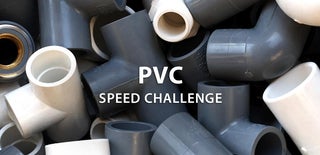Introduction: PVC Minimalist Jewelry Box/ Small Container
In need of a space-saving container to store jewelry, I created this white, swiveling stacked jewelry box from PVC end caps. I really enjoyed the action of swivel containers, and its upward stacking allows it to take up very little space on my dresser. Additionally, multiple containers allow me to keep my jewelry organized and separated from each other.
In the instructions, I listed dimensions and quantities to allow for exact replication of what I created. You do not have to use the same exact materials. Think of what you'd like to store and where. You are free to create a narrower, wider, taller, or shorter stacking box! You can even paint designs and further personalize it.
Supplies
Materials:
- 4 PVC end caps, not the rubbery ones (50 mm diameter)
- 1 brass rod (4 mm diameter or 1/8")
- 1 piece of white acrylic (to cut with laser cutter, or buy a 2.5" diameter acrylic disk!)
- Fast drying epoxy like Araldite rapid 5 minute (you'll only use a tiny bit. do not use UV curing epoxy)
- Wall putty (optional for filling in mis-drilled holes)
Tools:
- Laser cutter (to cut the acrylic; can omit by buying an acrylic disk of 2.5" diameter)
- Drill with a 4 mm drill bit or 1/8" drill bit
- Hand saw (to cut the brass rod, can omit if you buy a rod the proper length)
- Sandpaper
- Permanent marker
- Blu Tak or other non-permanent, pliable material to create an epoxy well
- Super glue
Step 1: Cut Acrylic
If applicable, cut the acrylic to a 2.5 inch circle using a laser cutter. You can alternatively just buy a disk like this one.
Step 2: Drill Holes
First take a measurement and mark with a permanent marker where your hole will reside. I only eyeballed to be a little less than a quarter of the diameter, but the exact measurement is close to 5/8ths inch... eyeballing leads to odd measurements.
Because a PVC end cap is rounded, marking your measurement point can be difficult. You can use the metal hook of a tape measure and wrap it around the edge. You can also create a tool using the power of tangent lines as shown in the picture above. You can find a piece of wood or some other material that is about the right depth, tape your permanent marker into place, and push your socket up against the wood and marker. The most important thing is that you measure consistently for each PVC end cap and the acrylic circle.
Next, (have your husband) drill holes through the PVC end caps and the acrylic circle. If you're using a drill bit that is smaller than your brass rod, you'll need to swivel the drill around to create a hole wide enough for the rod to fit through.
Step 3: Check Alignment
Pipe the brass rod through the holes you just drilled. Widen any holes if the rod doesn't fit or if PVC sockets are misaligned.
Also check that your swivel action works without collapsing by swiveling out each end cap and try rocking it up and down. It should not rock by a large amount. If it rocks a lot or feels like it would collapse, the hole is too close to the edge. This check ensures that your stacked container will be able to support itself and its contents.
Make sure that there is sufficient room for you to put things in when it swivels out as well. If the opening is too narrow, the hole is too close to the center. Adjust the position of the holes as needed. The holes can be filled in with wall putty later.
Step 4: Trim Brass Rod
Measure the height of your stacked PVC end caps + the thickness of your acrylic. Mine was about 5.25 inches. Use a permanent marker to record the length directly onto the rod.
(Enlist your husband to) cut the brass rod to the proper length using the hand saw. Lightly sand the freshly cut rod.
At this point, your container pieces are ready for assembly. If you would like to paint any designs or clean away any scratches, do so now. Any traces of permanent marker can be removed with rubbing alcohol, if you wish to remove them.
Step 5: Permanently Secure Brass Rod
Reminder: before starting this step, please check alignment since epoxy creates a permanent bond. Clean away any scratches or marker lines, or paint designs if you choose to . This is the last time you'll be able to fully disassemble the container.
- Create a small well for the epoxy using Blu Tack or another pliable material that doesn't interact with epoxy. This well determines what kind of base holds your rod in place. Be sure to stopper the bottom end of the hole so that you don't create a permanent bond with your tabletop surface.
- Mix the epoxy as instructed by the manufacturer and pour a small amount to fill your tiny well.
- Put the brass rod into the well with all containers stacked on top. This ensures that the rod is straight.
- Allow the epoxy to cure as instructed by the manufacturer.
- Remove the Blu Tack
Step 6: Permanently Secure Lid
- Align your lid one last time.
- Put a dot of superglue onto your brass rod and another dot onto the hole you drilled on your acrylic disk.
- Hold or clamp them together to give the glue time to cure as instructed by the manufacturer
Step 7: Enjoy!
Fill your container with your items and enjoy this engaging design.

Participated in the
PVC Speed Challenge











